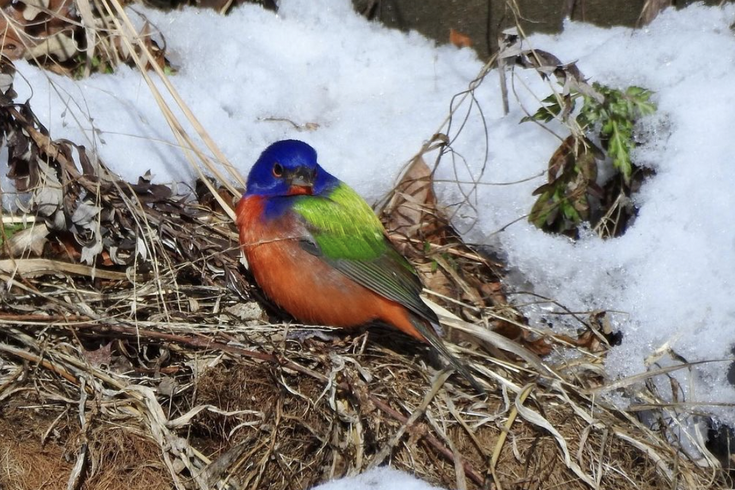
January 24, 2024
 @Victoria.Sindlinger/Instagram
@Victoria.Sindlinger/Instagram
A male painted bunting has made a rare appearance this winter at Bartram's Garden, the 50-acre public park in Southwest Philadelphia.
Philadelphia's birding community is getting a rare glimpse of a painted bunting that's made a home in and around Bartram's Garden this winter.
The species is part of the cardinal family and natively dwells in the southern U.S., Mexico, the Caribbean and Central America. When males mature, they molt to reveal their vibrantly colored plumage that fuses bright shades of blue, green, yellow and red.
Last Saturday, a vagrant painted bunting was spotted in a meadowy area on the north side of the 50-acre public garden in Southwest Philly. Word began to spread in chat groups on Telegram and other platforms where local birders connect to share sightings and information.
Victoria Sindlinger, an avid birder and photographer, was among the first to see the painted bunting after she saw a tip in a chat group.
"I had just sat down to have an early lunch. It was a cold day. I wasn't planning on going out anywhere," Sindlinger said. "I had my first spoonful of this really delicious chicken soup, but as soon as I heard painted bunting, I knew that was a bird I had to go for. I abandoned my food."
Sindlinger, 19, studies earth and environmental science at the University of Pennsylvania, not far from Bartram's Garden. She's been chasing and documenting birds since she took an ornithology class at 10 years old. She rushed over to Bartram's Garden to meet with others who spotted the painted bunting.
"Usually when I chase rare birds, it's never a guarantee that you're going to see it. Even if I do, it might be after a long and sometimes frustrating search," Sindlinger said. "But this bird, we saw almost immediately. My first look of it was naked eye, not through binoculars. It just came flying right past us — beautiful thing lit up the sun, absolutely unmistakable and glowing."
Sindlinger managed to get several photos that show off the painted bunting's vivid feathers.
"For a while, it was extremely cooperative — just doing really, really nice views," she said. "It's one of the most satisfying rare birds that I've seen in a while."
More and more people started showing up at Bartram's Garden on Saturday, beginning several days' worth of people visiting to see the bird.
The French name for the painted bunting is "nonpareil," meaning “without equal," in reference to the male's dazzling feathers. Females have a distinctive green plumage. Famed naturalist and ornithologist John J. Audubon lamented in the 19th century that painted buntings often were trapped illegally and shipped to Europe to be kept as cage birds, a practice that still remains a problem, according to the Cornell Lab of Ornithology.
Sindlinger said she previously saw one painted bunting in Florida, where it's native, and another in Delaware several years ago. Although it's uncommon to find them this far north — they're usually in Central America this time of year — the species is capable of surviving winters in the Delaware Valley.
Vagrancy occurs naturally for a variety of reasons, including weather patterns that push migratory birds off track — like the American flamingos that ended up in Pennsylvania last September. It may also happen because inexperienced young birds go in the wrong direction or have disorders that affect their navigation.
"For birds like the painted bunting, they're a seed eater," Sindlinger said. "As long as they land in a place with seeds, they can pretty much survive the winter."
The painted bunting at Bartram's Garden is an example of how maintaining habitats with native plants supports bird species, even in wintry conditions. Snow can cut off access to food for many seed-eating birds if they aren't able to comb for it in their usual places.
"Tall, native grasses have seed heads in the winter that poke above the snow and provide birds with food they wouldn't have access to anywhere else," Sindlinger said. "For a bird outside like this that's outside of its normal range, not particularly familiar with the area, having that accessible food source is absolutely vital to its survival."
Over the past several days, Sindlinger said the painted bunting has been moving in and out of Bartram's Garden.
"My understanding is that it has actually been favoring an area upriver of Bartram's outside of the garden proper," she said. "It's down along Mechanic Avenue."
Bartram's Garden noted on Instagram that some birders said they've seen painted buntings in Southwest Philly and elsewhere in the region in the past, including during the winter. It's possible the one living there now is a repeat visitor. The park's Welcome Center allows people to borrow binoculars on Fridays and Saturdays from 10 a.m. to 3 p.m.
Sindlinger said she may go back to Bartram's Garden to try to spot the painted bunting again. In the meantime, she decided to pay tribute to the colorful bird by baking a cake with a drawing of a painted bunting.
"Basically, my go-to when decorating cakes is birds. It's what I know how to draw, it's what I like," Sindlinger said. "I just figured I had seen this remarkably colorful bird, so why not?"